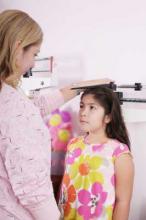
Physical development refers to the physical and biological changes that occur in humans between birth and adolescence.1 As a child grows and changes, he increases his ability to explore and interact with the world around him.2
There are a number of principles involved in a child’s physical development. The child’s physical abilities grow in a directional pattern from large muscle groups to small muscles, from head to toe, and from the center of the body to the extremities. General movements develop into more specific movements and are integrated to perform more complex physical activities. Physical abilities will vary at different ages and at different rates, but will be in a sequential order, since a child must be able to stand before he can walk.3
Developmental milestones indicate a child’s physical ability at different ages. These milestones are common guidelines that will vary in timing from child to child. Physical development can be influenced by genetics, size at birth, nutrition, body build, birth order, temperament, social class, ethnicity, and culture.4
From birth to 2 years of age children physically experience a rapid growth and change in the proportions of their body parts. Their ability to get around increases along with their development of eye-hand coordination. From 2 to 6 years of age children lose their babyish appearance and develop more mature proportions of their bodies as their arms and legs lengthen. They exhibit boundless energy for physical activities, with boys generally being more active than girls. By school age, children show steady gains in height and weight and go through the loss and replacement of their primary teeth. They have physically refined the use of their muscle groups and can participate in structured play activities.5
The physical movement of the muscles in the body is divided into two skill groups: gross motor skills and fine motor skills. Gross motor skills use the larger movements of the arms, legs, feet, or the entire body when performing activities, such as crawling, running, and jumping. Fine motor skills are smaller actions using the hands, wrists, fingers, feet, and toes to perform activities, such as grasping objects. Both types of motor skills usually develop together, since coordination of these skills is required for many activities.6
Infants
Infants first learn to lift their heads and shoulders, then proceed gradually from rolling over to creeping on their stomachs and finally crawling. As they begin to climb and support their weight in a standing position, they develop the ability to walk.7 Fine motor skills for infants require eye-hand coordination and the ability to grasp an object.8
Toddlers
Toddlers can run, climb stairs, and begin to kick and throw balls, although they will have difficulty catching balls.9 The fine motor skills become more sophisticated as they can scribble with crayons, turn book pages, and stack blocks. The dominance of either their right or left hand usually emerges at this stage.10
Preschoolers
Preschoolers can hop, jump over objects, and catch and throw balls more precisely.11 Developing more delicate fine motor skills is a challenge that requires patience, which preschoolers have in short supply. Their central nervous system is still in the process of maturing to sufficiently relay complex messages from the brain to their fingers.12
School Age
By school age, children can ride bicycles, jump rope, and play a variety of games using balls, which require eye-hand coordination, visual perception, and coordination.13 They can draw, paint, make crafts, and put puzzles together. Children will continue to develop their fine motor skills through sports, hobbies, computer use, and learning musical instruments.14
As children mature, they continually use their muscles in more complex ways. Play allows children to practice these complicated actions and helps them develop an awareness of body, space, and direction. Physical development is enhanced by children’s play.15
- 1. “What is Physical Development?” Reference.com. < http://answers.reference.com/Wellness/Mind/what_is_physical_development > 26 Oct. 2010.
- 2. Brotherson, Sean. “Understanding Physical Development in Young Children.” North Dakota State University. < http://www.ag.ndsu.edu/pubs/yf/famsci/fs632w.htm > 25 Oct. 2010.
- 3. Ibid.
- 4. Ibid.
- 5. McDevitt, T. m. and J. E. Ormrod. “Developmental Trends: Physical Development at Different Ages.” Education.com. < http://www.education.com/reference/article/physical-development-different-age/ > 25 Oct. 2010.
- 6. “Fine Motor Skills.” Encyclopedia of Children’s Health. < http://www.healthofchildren.com/E-F/Fine-Motor-Skills.html > 22 Oct. 2010.
- 7. “Gross Motor Skills.” Encyclopedia of Children’s Health. < http://www.healthofchildren.com/G-H/Gross-Motor-Skills.html > 22 Oct. 2010.
- 8. Op. cit., “Fine Motor Skills.”
- 9. Op. cit., “Gross Motor Skills.”
- 10. Op. cit., “Fine Motor Skills.”
- 11. Op. cit., “Gross Motor Skills.”
- 12. Op. cit., “Fine Motor Skills.”
- 13. Op. cit., “Gross Motor Skills.”
- 14. Op. cit., “Fine Motor Skills.”
- 15. Henniger, M. L. “Play and Physical and Emotional Development.” Education.com. < http://www.education.com/reference/article/play-physical-emotional-development/ > 25 Oct. 2010.

